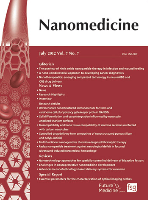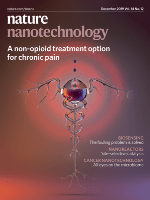
Nanomedicine
Scope & Guideline
Transforming Medical Practices with Nanomedicine Insights
Introduction
Aims and Scopes
- Nanoparticle-based drug delivery systems:
Research on various nanoparticle formulations designed for targeted and controlled drug delivery, enhancing therapeutic efficacy while minimizing side effects. - Theranostics:
Integration of therapeutic and diagnostic capabilities in nanomedicine, allowing for real-time monitoring of treatment responses and disease progression. - Nanotechnology in cancer treatment:
Exploration of nanomaterials that can be used for cancer therapy, including drug delivery, photothermal therapy, and immunotherapy. - Biocompatibility and toxicity studies:
Investigation of the biocompatibility and potential toxic effects of nanomaterials on biological systems, crucial for their clinical application. - Innovative formulations and synthesis methods:
Development of novel nanoparticles and nanocarriers, including lipid-based, polymeric, and metal nanoparticles, to improve drug solubility and stability. - Nanomedicine for infectious diseases:
Utilization of nanotechnology to enhance the efficacy of treatments against bacterial, viral, and fungal infections, including the development of vaccines. - Nanotechnology in regenerative medicine:
Application of nanomaterials in tissue engineering and regenerative therapies, focusing on enhancing healing and regeneration processes.
Trending and Emerging
- Personalized nanomedicine:
An increasing number of studies are focusing on tailoring nanomedicine approaches to individual patient profiles, enhancing treatment efficacy and safety. - Smart and stimuli-responsive nanocarriers:
Research on nanocarriers that respond to specific stimuli (e.g., pH, temperature, or light) to release drugs at targeted sites is gaining momentum, showcasing advanced delivery systems. - Nanomedicine for chronic diseases:
Emerging research is focusing on the application of nanotechnology in managing chronic diseases such as diabetes and cardiovascular conditions, reflecting a shift towards long-term health management. - Combination therapies using nanotechnology:
There is a growing trend in combining nanomedicine with other therapeutic modalities, such as immunotherapy and gene therapy, to enhance overall treatment outcomes. - Nanotechnology in vaccine development:
The COVID-19 pandemic has accelerated interest in nanotechnology's role in vaccine development, leading to innovative delivery systems and adjuvants. - Artificial intelligence in nanomedicine:
Integration of AI and machine learning in the design, synthesis, and application of nanomedicines is emerging as a significant theme, indicating a technological evolution in the field.
Declining or Waning
- Traditional small molecule therapies:
There is a noticeable decrease in studies focusing on conventional small molecule drugs as researchers shift towards more innovative nanomedicine approaches. - Basic mechanistic studies of nanoparticles:
Research that solely focuses on the fundamental mechanisms of nanoparticle interactions without clinical relevance is becoming less prevalent, as the field moves towards translational research. - In vivo studies in animal models:
Although still important, there is a growing preference for human-relevant models and clinical trials, leading to fewer publications centered on animal studies. - Nanoparticle applications in non-biomedical fields:
The focus on nanotechnology applications outside of direct medical contexts, such as environmental or industrial applications, is diminishing within the journal's scope.
Similar Journals

Beilstein Journal of Nanotechnology
Advancing the frontiers of nanotechnology research.The Beilstein Journal of Nanotechnology is a prominent open access journal published by the Beilstein Institute that has been at the forefront of nanotechnology research since its inception in 2010. With a focus on cutting-edge developments in areas such as Electrical and Electronic Engineering, Materials Science, and Physics and Astronomy, this journal is ranked in the Q2 category across multiple scientific disciplines, reflecting its significant impact within the research community. The journal is accessible to a global audience and aims to foster innovation and application of nanotechnology across various fields. Featuring a rich convergence of interdisciplinary studies, the Beilstein Journal of Nanotechnology offers a platform for researchers to share their findings, thus advancing the frontiers of knowledge in this dynamic field. With publishers based in Frankfurt am Main, Germany, it continues to contribute to the scientific dialogue on nanoscience and its practical applications, making it an essential resource for academics, professionals, and students eager to stay at the cutting edge of technology.

ACS Nano
Innovative Insights in Nanoscience and EngineeringACS Nano, published by the American Chemical Society, stands as a prestigious journal in the domains of Engineering, Materials Science, Nanoscience, and Physics. With an exceptional impact factor reflecting its standing as a Q1 category journal in multiple disciplines, it plays a pivotal role in disseminating groundbreaking research from 2007 to 2024. Known for its rigorous peer-review process, the journal boasts impressive Scopus rankings—positioned at #1 in General Engineering and #6 in General Physics and Astronomy—placing it among the top 1% of journals in its field. Although it is not an open-access publication, ACS Nano provides a wealth of knowledge that is essential for advancing the development of nanotechnology and its applications across various industries. Researchers, professionals, and students alike will find in its pages a trove of innovative studies and insights that drive the future of materials science and engineering.

Journal of Experimental Nanoscience
Unlocking Innovations in NanotechnologyThe Journal of Experimental Nanoscience, published by Taylor & Francis Ltd, is an esteemed open-access journal dedicated to advancing the field of nanoscience and its applications across various disciplines. Since its establishment, the journal has aimed to provide a comprehensive platform for researchers and professionals to disseminate innovative findings in nanotechnology, bioengineering, and materials science. With an ISSN of 1745-8080 and E-ISSN of 1745-8099, this journal has been pivotal in promoting high-quality research in its converged years from 2006 to 2024. Recognized for its contributions, it currently holds a Q3 ranking in core categories such as Bioengineering, Biomedical Engineering, Materials Science, and Nanoscience and Nanotechnology. Although its H-index is not specified, its Scopus ranks reflect its growing influence, with notable percentiles in various engineering fields. By offering open access since 2016, the Journal of Experimental Nanoscience enhances the accessibility of vital research to a global audience. Researchers, professionals, and students will find this journal an invaluable resource for staying abreast of the latest advancements and breakthroughs in nanoscience.

BIOMATERIALS
Pioneering Innovations in Bioengineering and BeyondBIOMATERIALS, published by Elsevier Science Ltd, is a premier academic journal dedicated to the interdisciplinary field of biomaterials research. With an impressive impact factor, it ranks in the Q1 quartile across multiple categories including Bioengineering, Biomaterials, and Biophysics, showcasing its significance in advancing scientific knowledge. Established in 1980 and set to converge its discussions through 2025, this journal provides a critical platform for researchers and professionals to disseminate their findings on the development, application, and performance of biomaterials. The journal covers a wide range of topics, from the mechanics of materials to nanotechnology, and is highly regarded with top Scopus rankings in essential categories, including an exceptional position within the 99th percentile for Biophysics. Although not an open access journal, BIOMATERIALS remains vital for students and established researchers alike, ensuring accessibility to groundbreaking research in the field. Engage with cutting-edge studies that pave the way for innovative applications in medicine, engineering, and beyond.

Current Drug Delivery
Pioneering research to enhance therapeutic efficacy.Current Drug Delivery, published by Bentham Science Publishers Ltd, serves as a vital platform for advancing the field of pharmaceutical sciences. With an ISSN of 1567-2018 and an E-ISSN of 1875-5704, this esteemed journal focuses on all aspects of drug delivery systems, encompassing innovative research and developments that aim to improve therapeutics and patient outcomes. Operating from the United Arab Emirates, it has an impressive standing reflected in its 2023 Q2 ranking in Pharmaceutical Sciences and a notable position within the 62nd percentile in Scopus’s Pharmacology, Toxicology, and Pharmaceutics category. The journal not only acts as an essential resource for researchers and professionals but it also encourages the dissemination of knowledge among students and budding scientists. With the latest articles and reviews converging from 2004 to 2024, Current Drug Delivery remains committed to offering high-quality content that enhances understanding and sparks innovation in drug delivery mechanisms.

Nano LIFE
Innovating solutions through nanoscale research.Nano LIFE, published by World Scientific Publishing Company, is a multidisciplinary journal that delves into the dynamic fields of bioengineering, biomedical engineering, and pharmaceutical science, providing a platform for researchers to disseminate their cutting-edge findings. With an ISSN of 1793-9844 and e-ISSN 1793-9852, this journal emphasizes the significance of nanoscale research in healthcare and technology, positioning itself as a vital resource for professionals and academics alike. Although currently categorized in the Q4 quartile for multiple scientific disciplines in 2023, its unique focus on the intersection of nanotechnology and life sciences aims to elevate the discourse in these rapidly evolving sectors. Researchers can anticipate publishing innovative methodologies and results, contributing to the overall understanding and application of nanotechnology in medicine. Located in Singapore, Nano LIFE not only serves the global research community but also reflects the growing interest in nanotechnology across diverse fields.

Cancer Nanotechnology
Unlocking the Potential of Nanotechnology in OncologyCancer Nanotechnology is a cutting-edge peer-reviewed journal dedicated to advancing the field of cancer research through innovative nanotechnology applications. Published by SPRINGER WIEN, this open-access journal, established in 2010, provides a vital platform for the dissemination of high-quality research with a focus on the intersection of nanotechnology, oncology, and biomedical engineering. With a commitment to promoting accessibility and fostering collaboration, Cancer Nanotechnology has gained impressive rankings within specialized categories, including Q2 in Biomedical Engineering and Pharmaceutical Science. The journal's rigorous selection process ensures that only the most impactful studies reach its audience, making it a must-read for researchers, professionals, and students eager to explore the latest advancements and methodologies in cancer treatment. With its scope encompassing critical topics that bridge multiple disciplines—including physical chemistry and toxicology—Cancer Nanotechnology positions itself as an influential resource for shaping the future of cancer therapies.

Nanomedicine-Nanotechnology Biology and Medicine
Exploring the Future of Medicine at the NanoscaleNanomedicine-Nanotechnology Biology and Medicine is a leading journal published by Elsevier, dedicated to the exploration of innovative applications of nanotechnology in the fields of biology and medicine. With an ISSN of 1549-9634 and an E-ISSN of 1549-9642, this esteemed journal provides a platform for high-quality research, comprehensively covering areas including bioengineering, biomedical engineering, pharmaceutical science, and nanoscience. Notably, it holds a significant position in various categories with a Q2 ranking in multiple disciplines and a prestigious Q1 ranking in Pharmaceutical Science, emphasizing its impact within the scientific community. By facilitating access to cutting-edge studies and advancements, Nanomedicine-Nanotechnology Biology and Medicine serves as an essential resource for researchers, professionals, and students alike, contributing significantly to the ongoing development of nanomedicine and its pivotal role in improving healthcare outcomes. The journal operates without open access; however, it remains committed to disseminating valuable knowledge to a global audience.

BioNanoScience
Innovating Health Solutions Through Nano-Engineering Excellence.BioNanoScience is an esteemed academic journal published by SPRINGER, dedicated to the interdisciplinary field of bioengineering and biomedical engineering. With an ISSN of 2191-1630 and an E-ISSN of 2191-1649, the journal has established itself as a significant platform for sharing innovative research and developments in nanotechnology as applied to biomedical contexts. Although it operates under a subscription model, the journal maintains a strong impact within its field, achieving a Q3 quartile ranking in both categories for 2023 and has a solid standing in Scopus rankings, where it ranks #129 out of 303 in Biomedical Engineering and #87 out of 162 in Bioengineering. The journal not only aims to publish high-quality research, but also seeks to foster collaboration between scientists, engineers, and healthcare professionals to address pressing global health challenges through nanotechnology. As an essential resource for researchers, professionals, and students, BioNanoScience continues to contribute to the advancement of knowledge and innovation in bioengineering.

Nature Nanotechnology
Unleashing Potential through Nanotechnology.Nature Nanotechnology, published by NATURE PORTFOLIO, stands at the forefront of scientific innovation, focusing on the rapidly evolving field of nanoscience and nanotechnology. With an impressive impact factor and ranking in the top Q1 quartiles across multiple disciplines—including Atomic and Molecular Physics, Bioengineering, and Materials Science—this journal is a pivotal resource for researchers and professionals dedicated to advancing knowledge and applications at the nanoscale. Its diverse scope encompasses cutting-edge research that bridges disciplines, addressing critical challenges in engineering, physics, and biomedical fields. Although the journal currently does not offer an open-access option, readers can access a wealth of information that is vital for anyone involved in pioneering research and development efforts. With its robust editorial standards and a commitment to publishing high-caliber, groundbreaking work, Nature Nanotechnology serves as an indispensable platform for the dissemination of transformative ideas that will shape the future of technology and science.